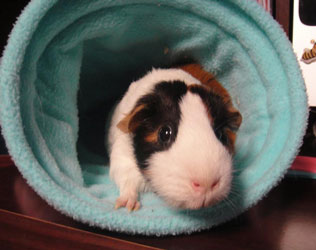Click through the following to learn about our adoption process.
Look into the care required for guinea pigs and take time to consider whether you will be able to provide the kind of care that guinea pigs require. Guinea pigs require a lot of attention and care and dine on grass based foods, to which some people are allergic thus making it impossible for them to care for guinea pigs. (Please check that you are not allergic to guinea pigs and the kinds of foods they need to be provided with when considering whether you want to adopt.)
We provide a list of good and reliable resources on guinea pig care on our website (here). Please note that resources not on our list may not contain accurate information about guinea pigs and how to care for them.
Please note, we have a "pairs policy". If you own a guinea pig, we are happy to help you find a compatible friend amongst ours. If you don't own a guinea pig, you may adopt a bonded pair or create a pair from our single guinea pigs. When you don't already own a guinea pig, we highly recommend adopting one of our bonded pairs - that way you know you have a pair that gets along, and won't run the risk of them not getting along once you get them home.
If you receive a response asking whether you are ready to initiate the adoption process, please respond. Once an affirmative response is received, you will be emailed sets of questions to check on your readiness to care for guinea pigs. These questions are asked both to those new and to those familiar with guinea pig care. We use your responses to educate or re-educate you or affirm your knowledge on how to best care for guinea pigs. We DO NOT require a certain number of questions to be answered correctly. We DO require that you demonstrate a sincere willingness and the ability to care for guinea pigs properly, which we will teach you through the question and answer sets, in order for adoption to occur.
Once you have shown a sincere willingness and the ability to care for guinea pigs properly, you will be asked to purchase the supplies needed to care for guinea pigs appropriately. MGPR will let you know what supplies you should and should not purchase. You will need to purchase the appropriate supplies and have them at home before your application can be approved.
Once your application is approved, you will be invited to one of our adoption meets. We cannot guarantee when you will be invited. You may be invited in the same month your application is approved, or you may be invited a month or more afterwards. It all depends on: the timing of approval (which may be just after the one and only adoption meet for the month has occurred); the number of applicants ahead of you and the pigs we have available to meet the requests of those applicants; and any extenuating circumstances that MGPR recognizes as being pertinent to the timing of adoption. MGPR will not make any accommodations to make adoption happen by a birthday or holiday. (Please note, MGPR does not allow guinea pigs to be adopted as gifts.)
At the adoption meet to which you are invited, you will work with an MGPR volunteer to find the perfect pair/pairing of guinea pigs.
Please note that MGPR creates male-female pairs because opposite-pairings tend to work best. On occasion, MGPR has bonded pairs of the same sex available. MGPR otherwise does not create male-male pairings and only rarely will allow female-female pairings to be created. All of our guinea pigs are fixed so there is no need to create a same sex pairing so as to prevent reproduction.
If you don't own a guinea pig already
If you own a guinea pig already
All piggies will travel home in the same carrier so as not to disrupt the bond between the piggies. When you arrive home, you can put the guinea pigs in the cage together. No quarantine is necessary as all of our pigs have received a health check. If you adopted just one pig from MGPR to pair with your own pig or created your own pair of pigs at the adoption meet (i.e., did not adopt a bonded pair), put the pigs in the cage in the following order:

If you have further questions, please look at our FAQ webpage for an answer. If you cannot find an answer or have a question not listed there, send an email to info@mgpr.org
Copyright © 2011 - All Rights Reserved - Metropolitan Guinea Pig Rescue
Template by OS Templates